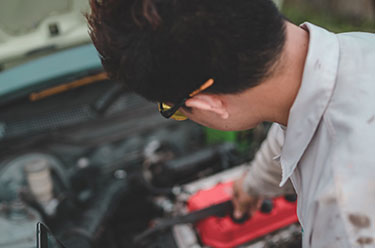

Someone once asked me what I thought was one of the most important but overlooked components in a vehicle. Hands down, I’d say it’s the battery. When it fails to start the engine, it quickly becomes the sole focus of your busy day. Whether the vehicle is in your driveway or stuck in a parking lot, your options become either getting the vehicle towed directly to a repair shop or finding someone to jump-start the vehicle in hopes of successfully making it to an auto parts store or a repair shop to buy a new battery. Either scenario can be stressful, inconvenient and costly, especially in unexpected situations.
Keeping Your Battery Happy
The last thing you need is an engine that won’t start because of a dead battery. Factors such as time, climate, maintenance and bad habits can negatively affect your battery’s life. Let’s look at each one and discuss how to minimize their influence on your battery’s longevity.
Time – The length of time your battery is guaranteed to last is usually an optimistic prediction based on the battery living in an ideal environment. Original equipment batteries typically last about 2-3 years. Replacement batteries can be guaranteed to last for 5+ years. Electric or hybrid batteries should last 8-10 years. To help avoid the unwelcome surprise of a dead battery at the most inopportune time, maintain your battery properly, test it at least once a year and replace it close to or at the end of its warranty period.
Climate – Hot and cold temperature extremes can be detrimental to a battery’s life span. High temps can cause accelerated evaporation of water from the battery’s electrolyte reserve and promote internal corrosion. When the temperature drops below 32 degrees, car batteries can lose significant strength (as much as 35%) and must work a lot harder to get cold engines started. The cold cranking amp (CCA) rating is important. When replacing your battery, it’s advised to look for a battery with equal or higher CCAs than the original battery, especially if the vehicle often operates in cold conditions. In cold or hot climates, be sure to check the electrolyte level often, keep the battery case clean and the cable connections corrosion-free and tight. Use only distilled water to service the electrolyte level in your battery. It is free of metals and minerals that can reduce your battery’s effectiveness.
Maintenance – Once every few months, open the hood to see how your battery is doing and perform a little maintenance. You’ll need a set of wrenches, a post or side terminal cleaner (battery terminal wire brush), a hydrometer, distilled water, a battery maintainer and a cable terminal puller. Everything you need is available at auto parts stores. If you need to replace the battery, you’ll have everything you need to get the job done. See the “To Do” list for maintenance tips.
To-Do List
WARNING: Battery acid is very caustic. It will burn your skin and put holes in your clothes. Wear Nytril or latex gloves, old clothes and eye protection when cleaning the battery, its terminals and cables or servicing the electrolyte level.
- Check the battery posts and cable terminals (clean and tighten if needed). Remove any corrosion and apply battery terminal grease upon reassembly.
- Check battery cable connections at both ends (clean and tighten if needed). In addition to the connections on the battery, check the negative cable where it attaches to the engine or battery tray and the positive cable where it attaches to the starter or starter solenoid.
- Check the electrolyte level (correct if needed).
- Test the battery’s state of charge – Follow the instructions that accompany your hydrometer. A fully charged battery should have a reading of 1.265 or higher. Replace the battery if cell readings differ from the others by .05 or more. If all the readings are fair or low (1.200 is low) but are consistent, charge the battery. (NOTE: No-maintenance batteries have a sight-glass. A green dot means the battery is good. Replace it if no color or any other color is visible).
- Corrosion and/or rust can disintegrate a battery tray. Occasionally or when replacing the battery, clean and repaint it if necessary.
- If your vehicle is parked more than a week between outings – especially in cold climates – keep your battery energized by connecting a battery maintainer that monitors battery voltage and automatically adjusts the charge to avoid under and overcharging the battery. NOTE: Match the battery maintainer with the type of battery you own (Examples: Lead Acid, Absorbent Glass Mat (AGM), Lithium Ion (Li-Ion) or Nickel Metal Hydride (NiMH).
Five Bad Habits to Avoid
Batteries fail more often due to poor driving and maintenance habits than manufacturer’s defects. Help your battery live a long and happy life by avoiding these common bad habits.
- Driving short distances too frequently. The alternator charges your battery while you drive. Frequent short trips do not allow the charging system enough time to fully charge the battery, which can lead to premature battery failure. Try to drive at least 20-30 minutes to keep the battery completely charged.
- Not performing routine battery and charging system maintenance. At the very least, follow the manufacturer’s recommendations for battery and charging system maintenance. In addition to battery care, check your alternator belt for cracks, wear and proper tension. A proactive maintenance program will help avoid a breakdown.
- Letting the vehicle sit without charging the battery. If the vehicle is not going to be driven, it’s best to use a battery maintainer. Batteries discharge naturally over time. If they sit too long, they can discharge to a point that can’t be revived by recharging. A new battery is the only option.
- Many vehicles today have headlights that turn on and off automatically and shut down soon after the ignition switch is turned off. Other vehicles have a feature that automatically shuts off all unnecessary electrical devices after turning the ignition switch off. If your vehicle isn’t equipped with these battery-saving features, be sure to shut off all electrical components like radios, blower fans or lights when your vehicle is parked. Leaving them on creates an excessive drain on the battery and can cause battery damage and shorten its lifespan. Tip: Turn your headlight switch off even if your lights shut down automatically. The lights will stay on for a while before they time out, which taxes your battery’s reserve.
- Overcharging the battery. Bad alternators and malfunctioning battery chargers are the most common cause of an overcharged battery, which can be dangerous. If you smell sulfur, see your battery case bulging out, the battery is very hot to the touch or notice the electrolyte level is dropping quickly, get your charging system and battery tested immediately. WARNING: Battery vapor can ignite. To avoid an explosion, keep all ignition sources like lit cigarettes, cell phones or battery chargers away from under the hood until the problem is resolved.
Finally, even the best-maintained batteries can fail when you least expect it. Having someone who will come out and replace the battery or give you a jump start anywhere, and at any time of day is a blessing. Subscribe to an auto club or have towing and roadside assistance included in your vehicle insurance policy.
Not an ALLDATAdiy customer? Learn how a subscription could help you. ALLDATAdiy provides access to repair information on over 44,000 engine-specific vehicles, find yours. Return to see more DIY Helpful Tips.






